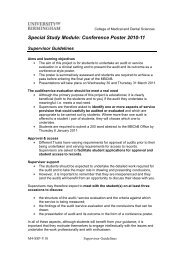Contents - College of Medical and Dental Sciences - University of ...
Contents - College of Medical and Dental Sciences - University of ...
Contents - College of Medical and Dental Sciences - University of ...
Create successful ePaper yourself
Turn your PDF publications into a flip-book with our unique Google optimized e-Paper software.
The 11 th International Workshop on KSHV & Related Agents, Birmingham, UK<br />
Clinical & Epidemiology Abstract 49<br />
HEIGHTENED REDOX STATUS OF PRIMARY EFFUSION LYMPHOMA CELLS CAN BE<br />
EXPLOITED THERAPEUTICALLY BY DECREASING RESISTANCE TO OXIDATIVE<br />
STRESS<br />
Darya Bubman 1 , Utthara Nayar 2 , Balasz Csernus 3 , Ilaria Guasparri 3 , Ethel Cesarman 3<br />
1= Program in Pharmacology, Weill Cornell Graduate School <strong>of</strong> <strong>Medical</strong> <strong>Sciences</strong>, 2=<br />
Program in Immunology <strong>and</strong> Microbial Pathogenesis, Weill Cornell Graduate School <strong>of</strong><br />
<strong>Medical</strong> <strong>Sciences</strong>, 3= Department <strong>of</strong> Pathology <strong>and</strong> Laboratory Medicine, Weill Cornell<br />
<strong>Medical</strong> <strong>College</strong><br />
Abstract<br />
Intracellular reactive oxygen species (ROS) levels are maintained in a fine balance; high<br />
levels can induce an oxidative stress response <strong>and</strong> cell death, while chronic moderately<br />
high levels may promote neoplastic growth <strong>and</strong> proliferation. Specifically, a high level <strong>of</strong><br />
the superoxide (O2 - ) species is associated with cellular transformation. We have shown<br />
that PEL cells have higher levels <strong>of</strong> ROS, particularly superoxide, than KSHV-negative<br />
cells. Furthermore, we showed that vFLIP is responsible for these high levels <strong>of</strong><br />
superoxide, by both overexpression <strong>and</strong> knockdown approaches. PEL cells also express<br />
high levels <strong>of</strong> superoxide dismutases (SODs), specifically MnSOD, which is probably<br />
necessary for PEL cells to eliminate superoxide <strong>and</strong> avoid oxidative stress. We therefore<br />
determined whether oxidative stress could be used as an approach for the treatment <strong>of</strong><br />
PEL. 2-Methoxyestradiol (2ME2), or Panzem (Entremed), is an endogenous metabolite <strong>of</strong><br />
estrogen that has antiangiogenic <strong>and</strong> antitumor effects, <strong>and</strong> is currently in early clinical<br />
studies for a variety <strong>of</strong> neoplasms. While 2ME2 acts through multiple mechanisms <strong>of</strong><br />
action, these include inhibition <strong>of</strong> SOD activity <strong>and</strong> disruption <strong>of</strong> angiogenesis through the<br />
inhibition <strong>of</strong> hypoxia inducible factor-1 alpha (HIF-1α), a protein required for<br />
angiogenesis <strong>and</strong> cell survival under hypoxic <strong>and</strong> oxidative stress. We therefore treated<br />
cells with 2ME2 in vitro, <strong>and</strong> demonstrated that PELs, but not normal lymphocytes, were<br />
extremely sensitive to drug. We also determined whether this drug is effective in vivo, by<br />
using a mouse PEL xenograft model with in vivo imaging, following oral administration <strong>of</strong><br />
clinically formulated 2ME2.<br />
Presenting author Email: utn2001@med.cornell.edu<br />
76















